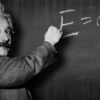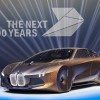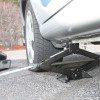Bayerische Motoren Werke AG (English: Bavarian Motor Works), commonly known as BMW or BMW AG, is a German automobile, motorcycle and engine manufacturing company founded in 1916.
BMW is headquartered in Munich, Bavaria, Germany. It also owns and produces Mini cars, and is the parent company of Rolls-Royce Motor Cars. BMW produces motorcycles under BMW Motorrad. BMW is part of the “German Big 3” luxury automakers, along with Audi and Mercedes-Benz, which are the three best-selling luxury automakers in the world.
BMW was established as a business entity following a restructuring of the Rapp Motorenwerke aircraft manufacturing firm in 1917. After the end of World War I in 1918, BMW was forced to cease aircraft engine production by the terms of the Versailles Armistice Treaty. The company consequently shifted to motorcycle production in 1923, once the restrictions of the treaty started to be lifted, followed by automobiles in 1928–29.
The first car which BMW successfully produced and the car which launched BMW on the road to automobile production was the Dixi, it was based on the Austin 7 and licensed from the Austin Motor Company in Birmingham, England.
BMW’s first significant aircraft engine was the BMW IIIa inline-six liquid-cooled engine of 1918, much preferred for its high-altitude performance. With German rearmament in the 1930s, the company again began producing aircraft engines for the Luftwaffe. Among its successful World War II engine designs were the BMW 132 and BMW 801 air-cooled radial engines, and the pioneering BMW 003 axial-flow turbojet, which powered the tiny, 1944–1945–era jet-powered “emergency fighter”, the Heinkel He 162 Spatz.
The BMW 003 jet engine was tested in the A-1b version of the world’s first jet fighter, the Messerschmitt Me 262, but BMW engines failed on takeoff, a major setback for the Emergency Fighter Program until successful testing with Junkers engines.Towards the end of the Third Reich BMW developed some military aircraft projects for the Luftwaffe, the BMW Strahlbomber, the BMW Schnellbomber and the BMW Strahljäger, but none of them were built.
By the year 1959, the automotive division of BMW was in financial difficulties and a shareholders meeting was held to decide whether to go into liquidation or find a way of carrying on. It was decided to carry on and to try to cash in on the current economy car boom enjoyed so successfully by some of Germany’s ex-aircraft manufacturers such as Messerschmitt and Heinkel.
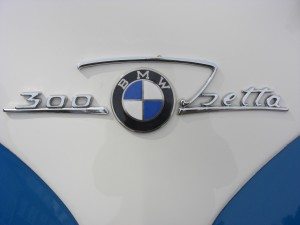 The rights to manufacture the Italian Iso Isetta were bought; the tiny cars themselves were to be powered by a modified form of BMW’s own motorcycle engine. This was moderately successful and helped the company get back on its feet.
The rights to manufacture the Italian Iso Isetta were bought; the tiny cars themselves were to be powered by a modified form of BMW’s own motorcycle engine. This was moderately successful and helped the company get back on its feet.
The controlling majority shareholder of the BMW Aktiengesellschaft since 1959 is the Quandt family, which owns about 46% of the stock. The rest is in public float. BMW acquired the Hans Glas company based in Dingolfing, Germany, in 1966. It was reputed that the acquisition was mainly to gain access to Glas’ development of the timing belt with an overhead camshaft in automotive applications. Glas vehicles were briefly badged as BMW until the company was fully absorbed.
In 1992, BMW acquired a large stake in California based industrial design studio DesignworksUSA, which they fully acquired in 1995. In 1994, BMW bought the British Rover Group (which at the time consisted of the Rover, Land Rover and MG brands as well as the rights to defunct brands including Austin and Morris), and owned it for six years.
By 2000, Rover was incurring huge losses and BMW decided to sell the combine. The MG and Rover brands were sold to the Phoenix Consortium to form MG Rover, while Land Rover was taken over by Ford. BMW, meanwhile, retained the rights to build the new Mini, which was launched in 2001.
Chief designer Chris Bangle announced his departure from BMW in February 2009, after serving on the design team for nearly seventeen years. He was replaced by Adrian van Hooydonk, Bangle’s former right hand man. Bangle was known for his radical designs, such as the 2002 7-Series and the 2002 Z4.
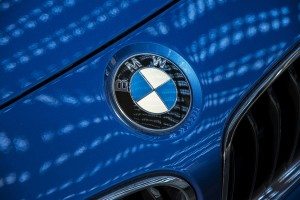 In July 2007, the production rights for Husqvarna Motorcycles was purchased by BMW for a reported 93 million euros. BMW Motorrad plans to continue operating Husqvarna Motorcycles as a separate enterprise. All development, sales and production activities, as well as the current workforce, have remained in place at its present location at Varese.
In July 2007, the production rights for Husqvarna Motorcycles was purchased by BMW for a reported 93 million euros. BMW Motorrad plans to continue operating Husqvarna Motorcycles as a separate enterprise. All development, sales and production activities, as well as the current workforce, have remained in place at its present location at Varese.
In June 2012, BMW was listed as the #1 most reputable company in the world by Forbes.com.
Rankings are based upon aspects such as “people’s willingness to buy, recommend, work for, and invest in a company is driven 60% by their perceptions of the company and only 40% by their perceptions of their products.”
About BMW Nomenclature
BMW vehicles follow a certain nomenclature; usually a 3 digit number is followed by 1 or 2 letters. The first number represents the series number. The next two numbers traditionally represent the engine displacement in cubic centimeters divided by 100.
However, more recent cars use those two numbers as a performance index, as e.g. the 116i, 118i and 120i (all 2,0L gas-powered), just like the 325d and 330d (both 3,0L diesel) share the same motor block while adjusting engine power through setup and turbocharging. A similar nomenclature is used by BMW Motorrad for their motorcycles.
The system of letters can be used in combination, and is as follows:
- A = automatic transmission
- C = coupé, last used on the BMW E46 and the BMW E63 (dropped after 2005 model year)
- c = cabriolet
- d = diesel
- e = eta (efficient economy, from the Greek letter ‘η’)
- g = compressed natural gas/CNG
- h = hydrogen
- i = fuel-injected
- L = long wheelbase
- s = sport, also means “2 dr” on E36 model
- sDrive = rear-wheel drive
- T = touring (wagon/estate)
- Ti = hatchback for the BMW 3 Series hatchback
- x / xDrive = BMW xDrive all-wheel drive
Exceptions
There are exceptions to the numbering nomenclature.
The M version of the BMW 1 Series was named the BMW 1 Series M Coupe rather than the traditional style “M1” due to the possible confusion with BMW’s former BMW M1 homologation sports car.
The M versions of the Sports Activity Vehicles, such as the X5 M, could not follow the regular naming convention since MX5 was used for Mazda’s MX-5 Miata.
For instance in the 2008 model year, the BMW 125i/128i, 328i, and 528i all had 3.0 naturally aspirated engines (N52), not a 2,500 cc or 2,800 cc engine as the series designation number would lead one to believe. The ’28’ is to denote a detuned engine in the 2008 cars, compared to the 2006 model year ’30’ vehicles (330i and 530i) whose 3.0 naturally aspirated engines are from the same N52 family but had more output.
The 2008 BMW 335i and 535i also have 3.0-litre engine; however the engines are twin-turbocharged (N54) which is not identified by the nomenclature. Nonetheless the ’35’ indicates a more powerful engine than previous ’30’ models that have the naturally aspirated N52 engine.
The 2011 BMW 740i and 335is shares the same twin-turbo 3.0 engine from the N54 family but tuned to higher outputs, although the badging is not consistent (’40’ and ‘s’). The 2013 BMW 640i Gran Coupe’s twin-scroll single turbo 3.0L inline-6 engine makes similar output to the older twin turbo inline-6 engines.
The E36 and E46 323i and E39 523i had 2.5-litre engines. The E36 318i made after 1996 has a 1.9 L engine (M44) as opposed to the 1.8 L (M42) used in the 1992 to 1995 models. The E39 540i had a 4.4 L M62 engine, instead of a 4.0 L as the designation would suggest.
The badging for recent V8 engines (N62 and N63) also does not indicate displacement, as the 2006 750i and 2009 750i have 4800 cc (naturally aspirated) and 4400 cc (twin-turbocharged) engines, respectively.
Marketing
BMW began using the slogan ‘The Ultimate Driving Machine’ in the 1970s. In 2010, this long-lived campaign was mostly supplanted by ‘Joy’, a campaign intended to make the brand more “approachable” and to better appeal to women, but by 2012 they had returned to “The Ultimate Driving Machine”, which has a strong public association with BMW.
Roundel Logo
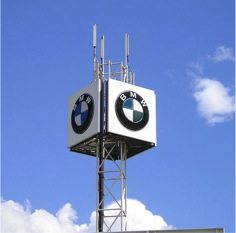 The circular blue and white BMW logo or roundel evolved from the circular Rapp Motorenwerke company logo, from which the BMW company grew, combined with the blue and white colors of the flag of Bavaria.
The circular blue and white BMW logo or roundel evolved from the circular Rapp Motorenwerke company logo, from which the BMW company grew, combined with the blue and white colors of the flag of Bavaria.
The logo has been portrayed as the movement of an aircraft propeller with the white blades cutting through a blue sky—first used in a BMW advertisement in 1929, twelve years after the roundel was created—but this is not the origin of the logo itself.
Community
From the summer of 2001 until October 2005, BMW hosted The Hire, showcasing sporty models being driven to extremes. These videos are still popular within the enthusiast community and proved to be a ground-breaking online advertising campaign.
Annually since 1999, BMW enthusiasts have met in Santa Barbara, CA to attend Bimmerfest. One of the largest brand-specific gatherings in the U.S., over 3,000 people attended in 2006, and over 1,000 BMW cars were present. In 2007, the event was held on 5 May.
About BMW slang
The English slang terms Beemer, Bimmer and Bee-em are variously used for BMWs of all kinds, cars and motorcycles. In the US, specialists have been at pains to prescribe that a distinction must be made between using Beemer exclusively to describe BMW motorcycles, and using Bimmer only to refer to BMW cars, in the manner of a “true aficionado” and avoid appearing to be “uninitiated.”
The Canadian Globe and Mail prefers Bimmer and calls Beemer a “yuppie abomination,” while the Tacoma News Tribune says it is a distinction made by “auto snobs.” Using the wrong slang risks offending BMW enthusiasts.
An editor of Businessweek was satisfied in 2003 that the question was resolved in favor of Bimmer by noting that a Google search yielded 10 times as many hits compared to Beemer.
The Arts
1975 BMW 3.0CSL painted by Alexander Calder. Manufacturers employ designers for their cars, but BMW has made efforts to gain recognition for exceptional contributions to and support of the arts, including art beyond motor vehicle design. These efforts typically overlap or complement BMW’s marketing and branding campaigns.
 The headquarters building, designed in 1972 by Karl Schwanzer, has become a European icon, and artist Gerhard Richter created his Red, Yellow, Blue series of paintings for the building’s lobby.
The headquarters building, designed in 1972 by Karl Schwanzer, has become a European icon, and artist Gerhard Richter created his Red, Yellow, Blue series of paintings for the building’s lobby.
In 1975, Alexander Calder was commissioned to paint the 3.0CSL driven by Hervé Poulain at the 24 Hours of Le Mans. This led to more BMW Art Cars, painted by artists including David Hockney, Jenny Holzer, Roy Lichtenstein, and others. The cars, currently numbering 17, have been shown at the Louvre, Guggenheim Museum Bilbao, and, in 2009, at the Los Angeles County Museum of Art and New York’s Grand Central Terminal.
BMW was the principal sponsor of the 1998 The Art of the Motorcycle exhibition at the Solomon R. Guggenheim Museum and other Guggenheim museums, though the financial relationship between BMW and the Guggenheim was criticized in many quarters.
The 2006 “BMW Performance Series” was a marketing event geared to attract black car buyers, and featured the “BMW Pop-Jazz Live Series,” a tour headlined by jazz musician Mike Phillips, and the “BMW Blackfilms.com Film Series” highlighting black filmmakers.
In 2012, BMW brought out the BMW Art Guide by Independent Collectors, which featured amongst others the Dikeou Collection. It is the first global guide to private and publicly accessible collections of contemporary art worldwide.
April Fools
BMW has garnered a reputation over the years for its April Fools pranks, which are printed in the British press every year. In 2010, they ran an advert announcing that customers would be able to order BMWs with different colored badges to show their affiliation with the political party they supported.
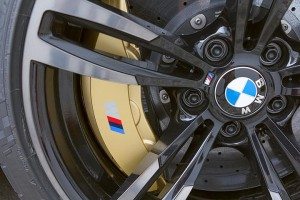 One way the BMW experience can be less than great, however, is when your BMW requires a visit to the dealer.
One way the BMW experience can be less than great, however, is when your BMW requires a visit to the dealer.
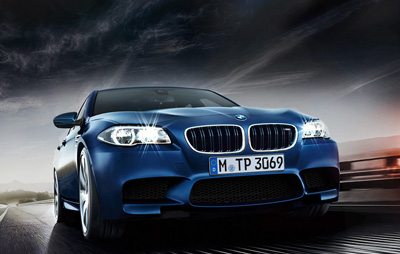 Coast Motor Werk is your premier dealership alternative for the service, maintenance and repair of BMW vehicles in Huntington Beach, Irvine, and Costa Mesa – just a short drive from the surrounding areas in Orange and LA Counties.
Coast Motor Werk is your premier dealership alternative for the service, maintenance and repair of BMW vehicles in Huntington Beach, Irvine, and Costa Mesa – just a short drive from the surrounding areas in Orange and LA Counties. The rights to manufacture the Italian Iso Isetta were bought; the tiny cars themselves were to be powered by a modified form of BMW’s own motorcycle engine. This was moderately successful and helped the company get back on its feet.
The rights to manufacture the Italian Iso Isetta were bought; the tiny cars themselves were to be powered by a modified form of BMW’s own motorcycle engine. This was moderately successful and helped the company get back on its feet. In July 2007, the production rights for Husqvarna Motorcycles was purchased by BMW for a reported 93 million euros. BMW Motorrad plans to continue operating Husqvarna Motorcycles as a separate enterprise. All development, sales and production activities, as well as the current workforce, have remained in place at its present location at Varese.
In July 2007, the production rights for Husqvarna Motorcycles was purchased by BMW for a reported 93 million euros. BMW Motorrad plans to continue operating Husqvarna Motorcycles as a separate enterprise. All development, sales and production activities, as well as the current workforce, have remained in place at its present location at Varese. The circular blue and white BMW logo or roundel evolved from the circular Rapp Motorenwerke company logo, from which the BMW company grew, combined with the blue and white colors of the flag of Bavaria.
The circular blue and white BMW logo or roundel evolved from the circular Rapp Motorenwerke company logo, from which the BMW company grew, combined with the blue and white colors of the flag of Bavaria. The headquarters building, designed in 1972 by Karl Schwanzer, has become a European icon, and artist Gerhard Richter created his Red, Yellow, Blue series of paintings for the building’s lobby.
The headquarters building, designed in 1972 by Karl Schwanzer, has become a European icon, and artist Gerhard Richter created his Red, Yellow, Blue series of paintings for the building’s lobby.